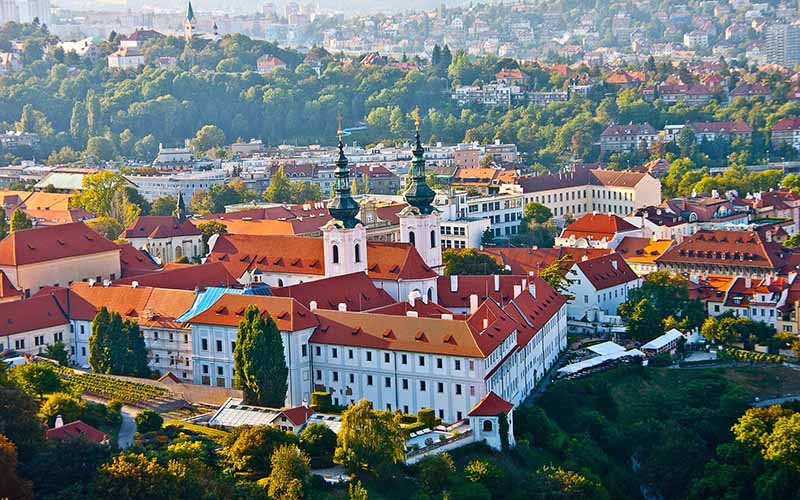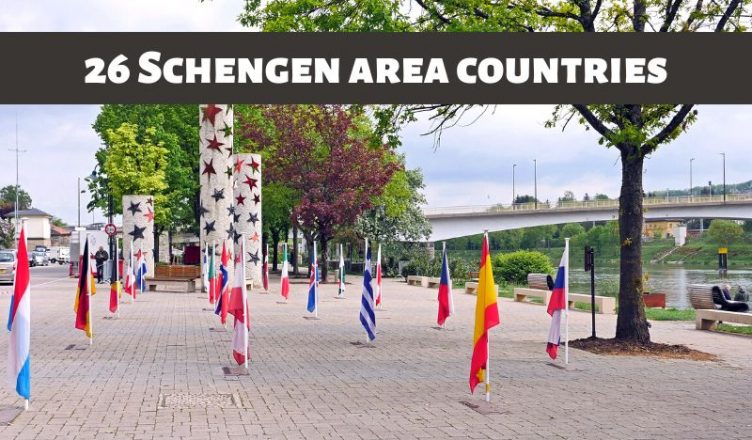If you are traveling to Europe and are looking at entering the Schengen Area that does not have a visa-free travel arrangement, you will need to apply for a Schengen visa. Due to the Schengen Agreement in 1985, citizens of member states can travel visa-free, and non-Schengen member countries are permitted to enter with a universal visa called a Schengen visa. This makes it possible for them to work, travel, or live in any other Schengen country.
Why is it called the “Schengen” Area?
The name ‘Schengen’ comes from a small winemaking town called Schengen on the River Moselle in southeastern Luxembourg, where Germany, France, Luxembourg, Netherlands, and Belgium signed the Schengen Agreement.
Schengen Area Countries
The Schengen Area comprises 26 European countries that agreed to create common entry and exit requirements to remove the need for internal borders. This agreement allows foreigners to travel freely between participating countries without undergoing border checks. The list of Schengen countries is as follows:
1) Austria

Austria, bordered by eight countries, is located in Central Europe. Austria is a non-coastal country with 8.95 million residents in Central Europe. This country signed the Schengen Agreement on 28th April 1995.
2) Belgium
Belgium is bordered by France, Netherlands, Germany, and Luxembourg. It signed the Schengen Agreement on 14th June 1985.
3) The Czech Republic

The Czech Republic is a landlocked country bordered by Poland, Slovakia, Austria, and Germany. The Schengen Agreement was signed by the Czech Republic on 16th April 2003.
4) Denmark

Denmark occupies the Peninsula of Jutland, extending northward from the center of Western Europe. The Schengen Agreement was signed on 19th December 1996.
5) Estonia
Estonia is a country in north-eastern Europe, bordered by three of the Baltic States. It has the Baltic Sea in the West, the Gulf of Finland in the North, Russia and Lake Peipus in the East, and Latvia in the South. Estonia has approximately thirteen lakh inhabitants. The Schengen Agreement was signed on 16th April 2003.
6) Finland
Finland is situated in northern Europe, having approximately five lakh inhabitants, bordered by Russia to the East, Norway to the North, and Sweden to the Northwest. The Schengen Agreement was signed on 19th December 1996.
7) France

France is situated in the western part of Europe, having over sixty million inhabitants. The Schengen Agreement was signed on 14th June 1985.
8) Germany
Germany is situated in the central and western parts of Europe, with the Czech Republic and Poland bordering in the east and Denmark in the north. It has a population of over eighty lakh inhabitants. The Schengen Agreement was signed on 14th June 1985. While Germany’s scenic landscapes have gained popularity, it offers visitors a wide variety of things to do in Germany that offer glimpses of its kaleidoscopic culture. This altogether makes this an excellent destination to explore for discerning travellers. For someone from UAE, the destination is an quite fascinating to explore and applying for a German tourist and visitor visa application from Dubai is also quite easy and hassle-free. Getting a Germany visa is easy when you are well-versed on all details about commonly asked questions and answers for Germany visa.
9) Greece

Greece, situated at the crossroads of Asia, Africa, and Europe, has approximately twelve million inhabitants. The Schengen Agreement was signed on 6th November 1992.
10) Hungary
Hungary, situated in Central Europe, has a population of almost ten lakh inhabitants. Hungary shares the borders with Slovenia in the west, Romania in the east, and Slovakia in the north. The Schengen Agreement was signed on 16th April 2003.
11) Iceland

Iceland, situated in the North Atlantic, has a population of almost 348,580 residents. It first signed the Schengen Agreement on 19th December 1996 and then a second agreement on 18th May 1999.
12) Italy
Italy, situated in the heart of the Mediterranean Sea, is bordered by France, Austria, Switzerland, Vatican City, San Marino, and Slovenia. Italy, having a population of almost sixty lakh inhabitants, signed the Schengen Agreement on 27th November 1990.
13) Latvia
Latvia shares the borders with Estonia in the north, Russia in the east, Belarus in the southeast, and Lithuania in the south. The Schengen Agreement was signed on 16th April 2003.
14) Liechtenstein
Liechtenstein is a noncoastal microstate in Central Europe. It has a population of almost forty thousand inhabitants. The Schengen Agreement was signed on 28th February 2008.
15) Lithuania
Lithuania shares a border with Latvia to the north, Belarus to the east, Kaliningrad Oblast to the southwest, and Poland to the south, having around three lakh inhabitants. The Schengen Agreement was signed on 16th April 2003.
16) Luxembourg

Almost six lakh people reside in Luxembourg. The Schengen Agreement was signed on 14th June 1985.
17) Malta
Malta is an island in the Mediterranean Sea, having a population of over four lakh inhabitants. The Schengen Agreement was signed on 16th April 2003.
18) The Netherlands
The Netherlands shares borders with Germany to the east, the North Sea to the northwest, and Belgium to the south. It has a population of almost seventeen million people. The Schengen Agreement was signed on 14th June 1985.
19) Norway

Norway shares its borders with Finland and Russia in the northeast, Skagerrak in the south, and Denmark on the other side. Norway has a population of almost six million people. The Schengen Agreement was signed on 19th December 1996.
20) Poland
Poland, situated in Central Europe, has a population of more than thirty lakh inhabitants. The Schengen Agreement was signed on 16th April 2003.
21) Portugal

Portugal shares the boundaries with Spain and has a population of nearly ten lakh inhabitants. The Schengen Agreement was signed on 25th June 1991.
22) Slovakia
Slovakia, a noncoastal country in Central Europe, has a population of almost fifty lakh inhabitants. Slovakia shares the borders with Poland in the north, Austria in the southwest, the Czech Republic in the west, Hungary in the south, and Ukraine in the east. The Schengen Agreement was signed on 16th April 2003.
23) Slovenia
Slovenia shares the borders with Italy to the west, Austria to its north, Hungary to the northeast, and Croatia to the southeast. Slovenia has a population of almost two lakh inhabitants. The Schengen Agreement was signed on 16th April 2003.
24) Spain

Spain shares the borders with France and the Bay of Biscay in the north and has nearly forty lakh inhabitants. The Schengen Agreement was signed on 25th June 1991.
25) Sweden
Sweden, situated in Northern Europe, shares borders with Norway and Finland. It has over ten million inhabitants. The Schengen Agreement signed by Sweden was on 9th December 1996.
26) Switzerland

Switzerland lies between Italy in the south, France in the west, Germany in the north, and Liechtenstein and Austria to the south. The Schengen Agreement was signed by Switzerland on 26th October 2004.
Types of Schengen Visa
If you are planning to visit multiple countries, you will need to apply for a Schengen visa at the embassy of the country you are looking to visit first. Depending upon the purpose of your visit, one can apply for any one of the following visa types:
- Tourist visa
- A Visa for visiting relatives or friends
- Business visa
- Study visa
- Medical Visa
- Internship or training visa
Depending on the number of times one can enter the Schengen area, you can apply for:
- A Single-entry Visa: A visa that allows one to enter the Schengen states only once.
- A Double-entry Visa: A visa that permits one to return only once after you have left the Schengen zone.
- A Multiple-entry Visa: A visa that allows one to enter the Schengen area many times within three to five years.
A Schengen visa allows you to stay in the Schengen Area for 90 days in six months.
There are some countries where you can enter with your Schengen visa, even though they are not a part of the Schengen Area. These countries are Vatican City, Monaco, and San Marino. Because of their political agreements and location, these countries have open borders with the Schengen Area.
Who Needs a Schengen Visa?
The nationals of non-Schengen countries need to obtain a Schengen visa. The Schengen Area has created a visa waiver for nationals of many countries from all around the world. If you are a national of a country that does not need a Germany visa, then you do not require a visa to other Schengen states.
The days you are allowed to stay in the Schengen countries are shorter than the validity of your visa. Be careful not to overstay your visa validity. If you do so, you may face a fine or a ban from travelling to the Schengen Area in the future.
